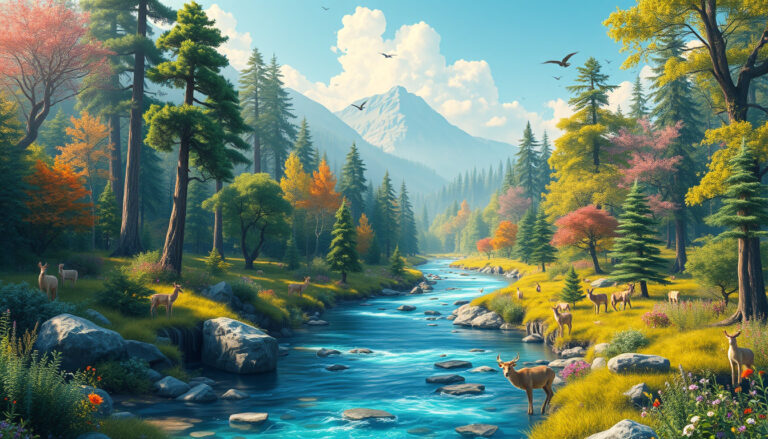Natural habitats are the lifeblood of our planet, serving as the home for countless species and contributing to the planet’s biodiversity.
Understanding the significance of these ecosystems is crucial for the conservation and protection of our environment.
In this guide, we will delve into the various types of natural habitats, exploring their unique characteristics, the incredible biodiversity they support, and the pressing need for conservation efforts.
From lush forests teeming with life to vast deserts showcasing resilience against the elements, each ecosystem plays a vital role in the Earth’s health.
Join us as we uncover the wonders of natural habitats and the critical importance of safeguarding them for future generations.


The Richness of Marine Habitats
Costa Rica is renowned for its stunning natural habitats, particularly its diverse marine ecosystems that offer visitors a chance to engage with nature like nowhere else.
The country’s extensive coastline, which stretches along both the Pacific Ocean and the Caribbean Sea, is home to a variety of marine habitats that support a wealth of biodiversity.
Coral reefs, mangroves, and estuaries are just a few examples of the natural habitats found in this Central American paradise.
These environments not only provide crucial nurseries for fish and other marine organisms but also play a vital role in the ecological balance of the region.
Snorkeling and diving enthusiasts flock to areas such as the National Park of Isla del Caño and the reefs of the Pacific coast to witness the vibrant life teeming beneath the waves.
In addition, conservation efforts in Costa Rica aim to protect these delicate marine ecosystems, ensuring that future generations can continue to enjoy their beauty and richness.
Whether you’re a nature lover or an eco-tourist, exploring Costa Rica’s marine habitats offers an unforgettable experience and a deeper appreciation for the natural world.
Desert Ecosystems: Surviving in Harsh Conditions
Desert ecosystems, often characterized by their arid conditions and extreme temperatures, are remarkable examples of nature’s resilience.
These environments, with their limited rainfall, can be harsh; however, the variety of life that thrives within them showcases a profound adaptability.
Many species have evolved unique adaptations to survive in this natural habitat, such as water conservation methods and nocturnal behaviors to avoid the searing daytime heat.
Flora like cacti have developed specialized structures to store water, while fauna such as camels or fennec foxes possess physiological traits that reduce water loss.
Exploring these fascinating adaptations not only highlights the ingenuity of life in such inhospitable conditions but also underscores the importance of conserving these natural habitats, which play a crucial role in the Earth’s biodiversity.

Freshwater Ecosystems: Lakes, Rivers, and Wetlands
Freshwater ecosystems in Costa Rica, which include lakes, rivers, and wetlands, serve as crucial natural habitats that support a diverse array of plant and animal life.
These ecosystems not only provide essential resources such as drinking water and fisheries but also play a significant role in regulating the climate and maintaining ecological balance.
In addition to their environmental importance, Costa Rica’s freshwater systems offer opportunities for eco-tourism, attracting visitors eager to explore the vibrant biodiversity found in these habitats.
From the serene waters of Lake Arenal to the winding rivers of the Osa Peninsula, the natural habitat of Costa Rica is a treasure trove for both nature enthusiasts and conservationists.
By understanding and preserving these ecosystems, we can ensure a sustainable future for the myriad species that depend on them and enhance the overall health of our planet.
Conservation Efforts: Protecting Our Natural Habitats
Costa Rica is renowned for its stunning biodiversity and rich natural habitats, which are home to an astonishing variety of flora and fauna.
The country has made significant strides in conservation efforts aimed at protecting these vital ecosystems.
This commitment is evident through the establishment of numerous national parks and reserves that cover around 25% of the country’s land area.
Communities and local governments prioritize sustainability and ecotourism, allowing visitors to experience the beauty of Costa Rica while contributing to conservation.
Initiatives include reforestation projects, wildlife protection laws, and education programs that encourage both locals and visitors to engage in preserving the natural habitat.
As a result, Costa Rica serves as a global model for balancing ecological integrity with economic development, ensuring that future generations can enjoy its remarkable landscapes and diverse wildlife.
Frequently Asked Questions
What exactly is a natural habitat?
A natural habitat is an environment where a particular species or community of organisms lives, grows, and thrives.
It includes all the biotic and abiotic factors that influence the ecosystem.
Why are natural habitats important for biodiversity?
Natural habitats are crucial for biodiversity as they provide the necessary resources, shelter, and conditions for various species to coexist, reproduce, and support complex ecological relationships.
What are some key characteristics of forest ecosystems?
Forest ecosystems are characterized by their rich biodiversity, multi-layered structure (canopy, understory, and forest floor), and the presence of a variety of tree species and wildlife that rely on these environments.
How do desert ecosystems adapt to harsh conditions?
Desert ecosystems have evolved with specific adaptations such as drought-resistant plants, nocturnal animal behavior, and efficient water conservation strategies to survive extreme temperatures and limited water availability.
What steps are being taken to protect our natural habitats?
Conservation efforts include creating protected areas, restoring degraded ecosystems, implementing sustainable practices, and raising public awareness about the importance of preserving natural habitats for future generations.





